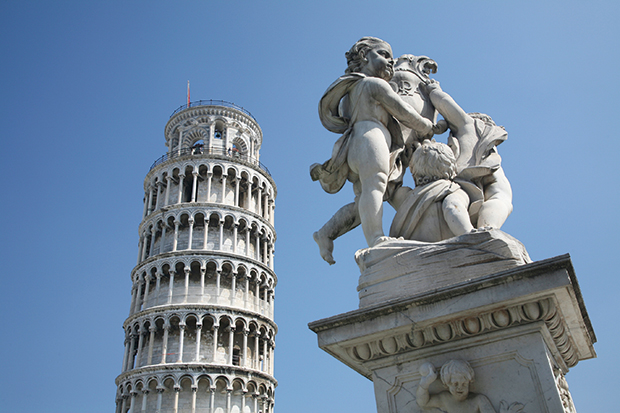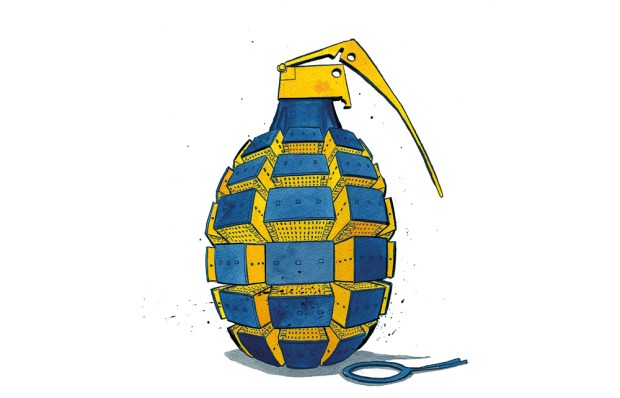Say ‘Pisa’ and everyone thinks of the Leaning Tower. Fair enough; it’s a curiosity, and the tourist board must be pleased that Mussolini’s plan to straighten it came to nothing. It stands, or leans, next to the cathedral in the Piazza dei Miracoli, and beyond the cathedral is the Baptistry, one of the most beautiful buildings in Italy.
I was in Pisa for the annual book festival, which attracts an extraordinary number of independent publishers and huge audiences (25,000 over a long weekend). Each year the director, Lucia della Porta, invites a foreign delegation, and this was Scotland’s turn. We were housed in the Royal Victoria Hotel, which dates from 1839, established with foresight to cater for middle-class tourists not rich enough, or staying long enough, to take a floor in a palazzo, unlike Byron and Shelley who both spent some months in Pisa (cheaper for the Shelleys than Florence) a few years earlier. Dickens was an early guest. The Royal Victoria has a pleasingly faded grandeur, and is just the thing if you like spacious rooms with marble floors and big windows that open on a view of the elegant unspoiled Lung’arno. Across the road from the hotel is a plaque recording that the boat carrying the hero Garibaldi, wounded in Aspromonte, docked there. Pretty well every Italian city has its Piazza Garibaldi and the statue of the hero in Pisa’s is particularly fine. It’s agreeable to sit there outside the Bar Centro, drinking coffee and smoking — naturally — a Garibaldi cigar.
Walk from there along the part-colonnaded Borgo Stretto and then through a myriad of twisting streets and you reach the beautiful Piazza dei Cavalieri. Thought to be the site of Roman Pisa’s forum, its present design is mostly the work of the 16th century Florentine architect Giorgio Vasari. The piazza was the base of the last order of crusading knights, founded in 1561 by Cosimo di Medici, whose statue stands in the piazza. I had foolishly assumed that the order was probably honorary. Not a bit of it. The Knights of San Stefano, specialising in naval warfare against the Turks and the Barbary pirates, took part in the Battle of Lepanto (1571) and the banner of the Turkish commander there hangs in the Church of San Stefano beside the knights’ residence, where young knights were put through a three-year course studying geography, cosmography, mathematics and strategy. The order was — meanly — dissolved by the new Kingdom of Italy in 1861 and the knights’ palace now houses the Scuola Nuova Normale, founded by Napoleon half a century previously.
For those with a taste for the macabre, one of the medieval towers, bridged by Vasari to form the Palazzo dell’Orologio, was the prison where the Guelf leader Count Ugolini della Gherardeschi, condemned by the City Fathers for treason, reputedly died of starvation in 1288, but not before he had staved off hunger by eating the bodies of his two children. He features, not surprisingly, in Dante’s Inferno, Canto XXXIII.
Finally, if you are lucky enough to be in Pisa in the next couple of months, go to the beautiful Palazzo Blu on the Lung’arno where there is a gorgeous Toulouse-Lautrec exhibition. It includes a few works by the Italian impressionist Federico Zandomeneghi, unknown to ignorant me but quite delightful.
Got something to add? Join the discussion and comment below.
Get 10 issues for just $10
Subscribe to The Spectator Australia today for the next 10 magazine issues, plus full online access, for just $10.
You might disagree with half of it, but you’ll enjoy reading all of it. Try your first month for free, then just $2 a week for the remainder of your first year.














Comments
Don't miss out
Join the conversation with other Spectator Australia readers. Subscribe to leave a comment.
SUBSCRIBEAlready a subscriber? Log in